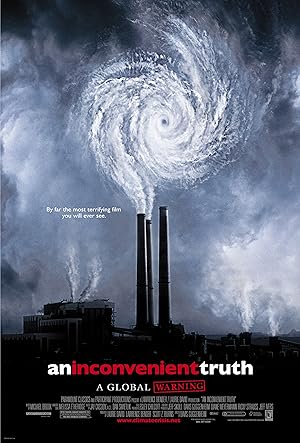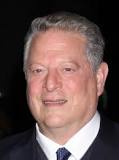
An Inconvenient Truth Page #2
Just like Daddy puts in his drink
every morning.
And then he gets mad.
Of course, since the greenhouse gases
it takes more and more ice each time.
Thus, solving the problem
once and for all.
- But...
- Once and for all!
This is the image that started me
in my interest in this issue.
And I saw it
when I was a college student
because I had a professor
named Roger Revelle
who was the first person to propose
measuring carbon dioxide
in the Earth's atmosphere.
He saw where the story was going
after the first few chapters.
After the first few years of data,
he intuited what it meant
for what was yet to come.
They designed the experiment in 1957.
He hired Charles David Keeling
who was very faithful and precise
in making these measurements
for decades.
They started sending
these weather balloons up every day
and they chose the middle of the Pacific
because it was the area
that was most remote.
And he was a very hard-nosed scientist.
He really emphasized the hard data.
It was a wonderful time for me
because, like a lot of young people,
I came into contact
with intellectual ferment,
ideas that I'd never considered
And he showed our class
the results of his measurements
after only a few years.
It was startling to me.
Now he was startled
and made it clear to our class
what he felt the significance of it was.
And I just soaked it up like a sponge.
He drew the connections
between the larger changes
in our civilization
and this pattern that was now visible
in the atmosphere of the entire planet.
And then he projected into the future
where this was headed
unless we made some adjustments.
And it was just as clear as day.
After the first seven, eight, nine years,
you could see the pattern
that was developing.
But I asked a question.
Why is it that it goes up and down
once each year?
And he explained that if you look
at the land mass of the Earth,
very little of it is south of the equator.
The vast majority of it is
north of the equator,
and most of the vegetation is
north of the equator.
And so, when the Northern Hemisphere
as it is in our spring and summer,
the leaves come out
and they breathe in carbon dioxide,
and the amount in the atmosphere
goes down.
But when the Northern Hemisphere is
tilted away from the sun,
as it is in our fall and winter,
the leaves fall
and exhale carbon dioxide,
and the amount in the atmosphere
goes back up again.
And so, it's as if the entire Earth
once each year breathes in and out.
So we started measuring
carbon dioxide in 1958.
And you can see
that by the middle '60s,
when he showed my class this image,
it was already clear that it was going up.
I respected him and learned from him
so much, I followed this.
And when I went to the Congress
in the middle 1970s,
I helped to organize the first hearings
on global warming
and asked my professor to come
and be the leadoff witness.
such a big impact,
we'd be on the way to solving
this problem, but it didn't work that way.
But I kept having hearings.
And in 1984 I went to the Senate
and really dug deeply into this issue
with science roundtables and the like.
ran for President in 1988,
partly to try to gain some visibility
for that issue.
And in 1992 went to the White House.
We passed a version of a carbon tax
and some other measures
to try to address this.
Went to Kyoto in 1997
to help get a treaty
that's so controversial,
in the US at least.
In 2000,
my opponent pledged to regulate CO2
and then...
That was not a pledge that was kept.
But the point of this is
all this time you can see
what I have seen all these years.
It just keeps going up. It is relentless.
And now we're beginning to see
the impact in the real world.
This is Mount Kilimanjaro
more than 30 years ago
and more recently.
And a friend of mine just came back
from Kilimanjaro
with a picture he took
Another friend, Lonnie Thompson,
studies glaciers.
Here's Lonnie with a last sliver
of one of the once mighty glaciers.
Within the decade there will be
no more snows of Kilimanjaro.
This is happening
I climbed to the top of this in 1998
with one of my daughters.
Within 15 years, this will be the park
formerly known as Glacier.
Here is what's been happening
year by year to the Columbia Glacier.
It just retreats every single year.
And it's a shame
'cause these glaciers are so beautiful.
But those who go up to see them,
here's what they're seeing every day,
now.
In the Himalayas
there's a particular problem
because 40% of all the people
in the world
from rivers and spring systems
that are fed more than half
by the melt water
coming off the glaciers.
And within this next half century
those 40% of the people on Earth
are gonna face a very serious shortage
because of this melting.
Italy, the Italian Alps.
Same sight today.
An old postcard from Switzerland.
Throughout the Alps,
we're seeing the same story.
It's also true in South America.
This is Peru 15 years ago.
And the same glacier today.
This is Argentina 20 years ago.
Same glacier today.
Seventy-five years ago in Patagonia
on the tip of South America.
This vast expanse of ice is now gone.
There's a message in this.
There's a message in this.
It is worldwide.
And the ice has stories to tell us.
My friend, Lonnie Thompson,
digs core drills in the ice.
They dig down
and they bring the core drills back up
and they look at the ice
and they study it.
When the snow falls,
it traps little bubbles of atmosphere
and they can go in and measure
how much CO2 was in the atmosphere
the year that that snow fell.
What's even more interesting, I think, is
they can measure
the different isotopes of oxygen
and figure out
a very precise thermometer
and tell you what the temperature was
the year that that bubble was trapped
in the snow as it fell.
When I was in Antarctica,
I saw cores like this.
And a guy looked at it. He said,
"Right here is where the US Congress
passed the Clean Air Act."
And I couldn't believe it.
But you can see the difference
with the naked eye.
Just a couple of years
after that law was passed,
it's very clearly distinguishable.
They can count back year by year
the same way a forester reads
tree rings.
And you can see each annual layer
from the melting and re-freezing,
so they can go back in a lot of these
mountain glaciers 1,000 years.
And they constructed a thermometer
of the temperature.
The blue is cold and the red is warm.
Now, I show this
for a couple of reasons.
Number one, the so-called skeptics
will sometimes say,
"Oh, this whole thing,
this is a cyclical phenomenon.
"There was a medieval warming period,
after all."
Well, yeah, there was.
Translation
Translate and read this script in other languages:
Select another language:
- - Select -
- 简体中文 (Chinese - Simplified)
- 繁體中文 (Chinese - Traditional)
- Español (Spanish)
- Esperanto (Esperanto)
- 日本語 (Japanese)
- Português (Portuguese)
- Deutsch (German)
- العربية (Arabic)
- Français (French)
- Русский (Russian)
- ಕನ್ನಡ (Kannada)
- 한국어 (Korean)
- עברית (Hebrew)
- Gaeilge (Irish)
- Українська (Ukrainian)
- اردو (Urdu)
- Magyar (Hungarian)
- मानक हिन्दी (Hindi)
- Indonesia (Indonesian)
- Italiano (Italian)
- தமிழ் (Tamil)
- Türkçe (Turkish)
- తెలుగు (Telugu)
- ภาษาไทย (Thai)
- Tiếng Việt (Vietnamese)
- Čeština (Czech)
- Polski (Polish)
- Bahasa Indonesia (Indonesian)
- Românește (Romanian)
- Nederlands (Dutch)
- Ελληνικά (Greek)
- Latinum (Latin)
- Svenska (Swedish)
- Dansk (Danish)
- Suomi (Finnish)
- فارسی (Persian)
- ייִדיש (Yiddish)
- հայերեն (Armenian)
- Norsk (Norwegian)
- English (English)
Citation
Use the citation below to add this screenplay to your bibliography:
Style:MLAChicagoAPA
"An Inconvenient Truth" Scripts.com. STANDS4 LLC, 2025. Web. 22 Feb. 2025. <https://www.scripts.com/script/an_inconvenient_truth_2787>.







Discuss this script with the community:
Report Comment
We're doing our best to make sure our content is useful, accurate and safe.
If by any chance you spot an inappropriate comment while navigating through our website please use this form to let us know, and we'll take care of it shortly.
Attachment
You need to be logged in to favorite.
Log In